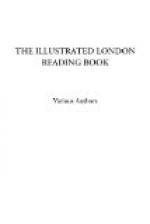[Illustration: GROUSE.]
The ptarmigan grouse is not only a native of Scotland but of the higher latitudes of continental Europe, and, perhaps, the changes of plumage in none of the feathered races are more remarkable than those which the ptarmigans undergo. Their full summer plumage is yellow, more or less inclining to brown, beautifully barred with zig-zag lines of black. Their winter dress is pure white, except that the outer tail-feathers, the shafts of the quills, and a streak from the eye to the beak are black. This singular change of plumage enables it, when the mountains are covered with snow, to escape the observation of the eagle, Iceland falcon, and the snowy owl: the feathers become much fuller, thicker, and more downy; the bill is almost hidden, and the legs become so thickly covered with hair-like feathers, as to resemble the legs of some well-furred quadruped.
* * * * *
PATMOS.
[Illustration: Letter P.]
Patmos affords one of the few exceptions which are to be found to the general beauty and fertility of the islands of the Aegean Sea. Its natural advantages, indeed, are very few, for the whole of the island is little else than one continued rock, rising frequently into hills and mountains. Its valleys are seldom susceptible of cultivation, and scarcely ever reward it. Almost the only spot, indeed, in which it has been attempted, is a small valley in the west, where the richer inhabitants have a few gardens. On account of its stern and desolate character, the island was used, under the Roman Empire, as a place of banishment; and here the Apostle St. John, during the persecution of Domitian, was banished, and wrote the book of the Revelations. The island now bears the name of Patino and Palmosa, but a natural grotto in the rock is still shown as the place where St. John resided. “In and around it,” says Mr. Turner, “the Greeks have dressed up one of their tawdry churches; and on the same site is a school attached to the church, in which a few children are taught reading and writing.”
[Illustration: PATMOS.]




